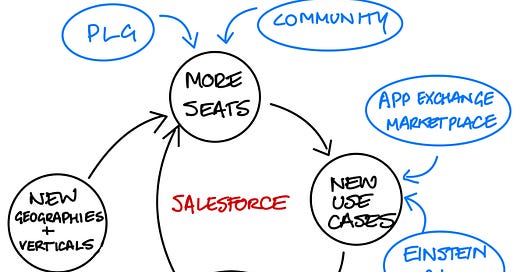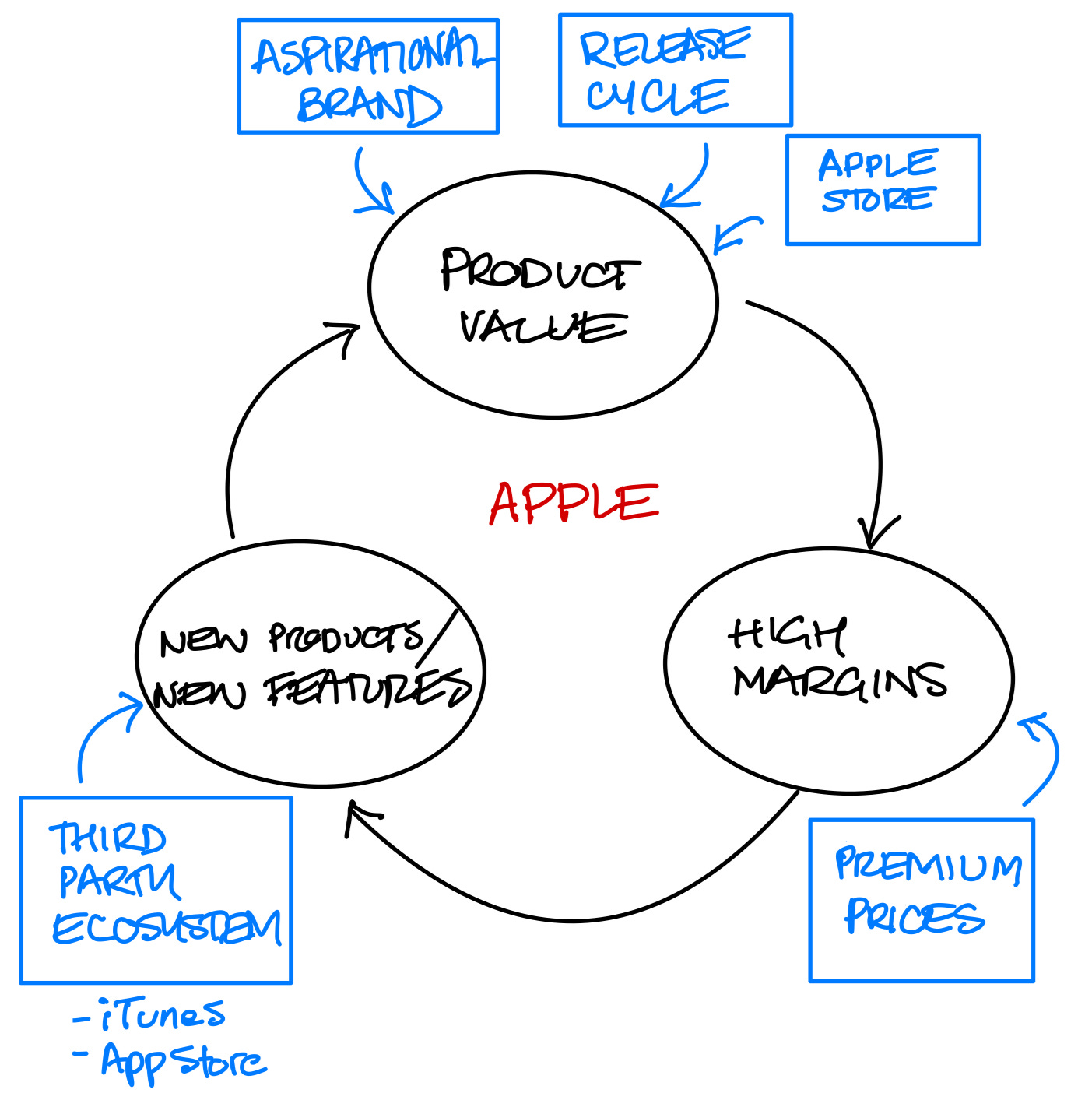Here's What I'm Obsessing About...December 2023
This month, I'm obsessing about flywheels (again), the cautionary (and salacious) tale of Ray Dalio, and the Paradox of Strengths...
(1) Your Strategy Game: Accelerate Your Flywheel
To me, in business, there is nothing more beautiful than a clear growth flywheel! You should obsess about yours.
Jim Collins’ book Turning The Flywheel is a decent foundation for building flywheels [⭐️⭐️⭐️] (Hat tip to Matt Blumberg for the recommendation!)
To me, Collins only scratches the surface of this important topic.
Here’s how I recommend CEOs think about their flywheels:
First, define the core flywheel: Identify the main drivers of supply and demand that work together to create growth. This should be the simplest understanding of your business.
Identify possible accelerants: How could you apply force to the different parts of the core flywheel so that you create disproportionate momentum?
To get your creative juices flowing, let’s consider three examples [Note: none are “official” flywheels, just guesses.]
(a) SaaS flywheel (e.g. Salesforce)
[Note: The “core flywheel” is in black while “accelerants” are in blue]
While Salesforce arguably pioneered Product-Led Growth in software, I think the unsung hero of its flywheel has been building community (of Salesforce Admins.) And Dreamforce is the gold standard for software community gatherings.
(b) Dual-sided marketplace flywheel (e.g. Uber)
Uber initially used significant price subsidies to accelerate its flywheel. But the genius of both Uber and Airbnb was to create new (non-traditional) supply, such as attracting retirees to become drivers, and homeowners to become hoteliers.
(c) Hardware flywheel (e.g. Apple)
A core flywheel usually includes improving product value. Apple’s third-party ecosystem (iTunes, App Store) clearly drives value, but they also drive perceived value via aspirational branding/design, and by releasing a new iPhone every year.
Coaching Inquiry
What ideas do the above flywheels trigger for you?
What flywheel experiments will you run in Q1?
(2) Your Leadership Game: Don’t Lead Like Ray Dalio!
To many, Ray Dalio is a respected investor and thinker, so The Fund (Rob Copeland) [⭐️⭐️⭐️] initially feels like a hit piece.
Copeland paints Dalio as a petty, narcissistic, bullying autocrat, and Bridgewater as a dystopian panopticon where Big Brother is always watching, and the Thought Police serve quick justice.
I believe Copeland. But even if you think the book is greatly exaggerated, it’s a cautionary tale for founders.
Here’s the lesson I think startup CEOs should learn from The Fund: You cannot create a culture where “the best ideas win.”
No: Your ideas will win, because you are CEO. So you’ll need to work hard to avoid believing in your own hype.
How did Dalio lose his grip on reality?
As Copeland tells it:
Dalio becomes a successful investor and believes he has a unique approach to decision-making.
He wants all Bridgewater employees to follow his approach, so he codifies the Principles and makes them mandatory.
Dalio thinks that radical transparency (e.g. recording all conversations) will ensure people follow The Principles.
He cajoles employees into ratting on their colleagues and voting on each other’s performance during meetings.
If someone runs afoul of The Principles, Dalio adjudicates a public trial and Bridgewater leaders vote on the outcome. Surprise: Everyone votes in Dalio’s favor! Dalio becomes more convinced that he has the answer.
Dalio thinks he has created a meritocracy. Instead, he has created an autocracy. Some truly horrible stories ensue!
The cautionary tale: Ego and role power are a potent mix.
As CEO, you have absolute role power, and since you risk being surrounded by “yes people”, your ego can easily get out of control.
Ten CEO Rules to avoid the Dalio ego trap:
Surround yourself with super-smart, opinionated leaders.
Create a culture of debate on your leadership team. Argue together regularly.
Share your opinion last.
Ask someone to play Devil’s Advocate.
Don’t aim for radical transparency; aim for candor with kindness.
Give negative feedback in private.
Use your veto power rarely.
In public: Give your team the credit, but accept fault yourself.
Perform a daily retrospective on your performance (What did I do well yesterday? What do I need to do differently today?)
Find someone to tell you when you’re full of crap! A cofounder is best.
Regularly say, “Sorry, I was wrong.” If you don’t, then invoke Rule #10.
Coaching Inquiry
Where/when do your ideas tend to win?
Who will be your Truth Teller?
(3) Your Mental Game: The Paradox Of Strengths
Sure, you should “soar with your strengths.” A visionary CEO should inspire the company at the All Hands and take center-stage fundraising.
But strengths are a double-edged sword; they create our weaknesses. That visionary CEO is often poor at executing the details.
To avoid the downsides, you need to understand the paradox that comes with your strengths.
What causes the Paradox of Strengths?
Blindspots. We think everyone else sees the world the way we do.
Over-Reliance. We use our strength as our go-to solution.
Confirmation Bias. We jump to conclusions that fit our strengths.
Underdevelopment. We let our weaknesses atrophy, assuming our strengths will compensate.
What paradoxes are most common?
Here’s what I see with my clients:
How can you avoid the Paradox of Strengths?
First: Lean into your strengths. Use those gifts!
Then:
Seek feedback. Get your coach to run a 360 for you. List your most common strengths and weaknesses.
For each strength, what is the opposite? How might you be guilty?
Identify one weakness, and target it this quarter. Ask your team's top expert in that area to teach you.
Tell your leaders that you have this blindspot and ask them to call you out if they see it in action.
Surround yourself with people who complete you. If you’re more inspirational/ empathic, hire a results-driven COO. If you are a commercial CEO, get a really strong CTO.
Coaching Inquiry
What are your three biggest strengths? What is the downside related to each?
What is your plan to compensate?
(4) One More Thing: Your People Are Not Doing So Well!
Lightspeed’s latest HR & People Trends Report is a must-read for CEOs. Big thanks to Luke Beseda of Lightspeed for the report and his analysis!
Here are three findings I think you should pay attention to, along with suggestions for responding:
Let me know what you think. And let’s talk if you want to take any of these topics further.
Thanks for reading,
Tim
P.S. Many of my obsessions stem from conversations with you, my clients. I don’t call you out to preserve anonymity, but please know you are my inspiration and teacher. I am so grateful.
![Obsessions Of A Startup CEO Coach [Tim Porthouse]](https://substackcdn.com/image/fetch/$s_!I7nv!,w_80,h_80,c_fill,f_auto,q_auto:good,fl_progressive:steep,g_auto/https%3A%2F%2Fsubstack-post-media.s3.amazonaws.com%2Fpublic%2Fimages%2F015bf8c6-dc7e-4789-ba60-314765baea1e_1128x1128.png)

![Obsessions Of A Startup CEO Coach [Tim Porthouse]](https://substackcdn.com/image/fetch/$s_!I7nv!,w_36,h_36,c_fill,f_auto,q_auto:good,fl_progressive:steep,g_auto/https%3A%2F%2Fsubstack-post-media.s3.amazonaws.com%2Fpublic%2Fimages%2F015bf8c6-dc7e-4789-ba60-314765baea1e_1128x1128.png)







